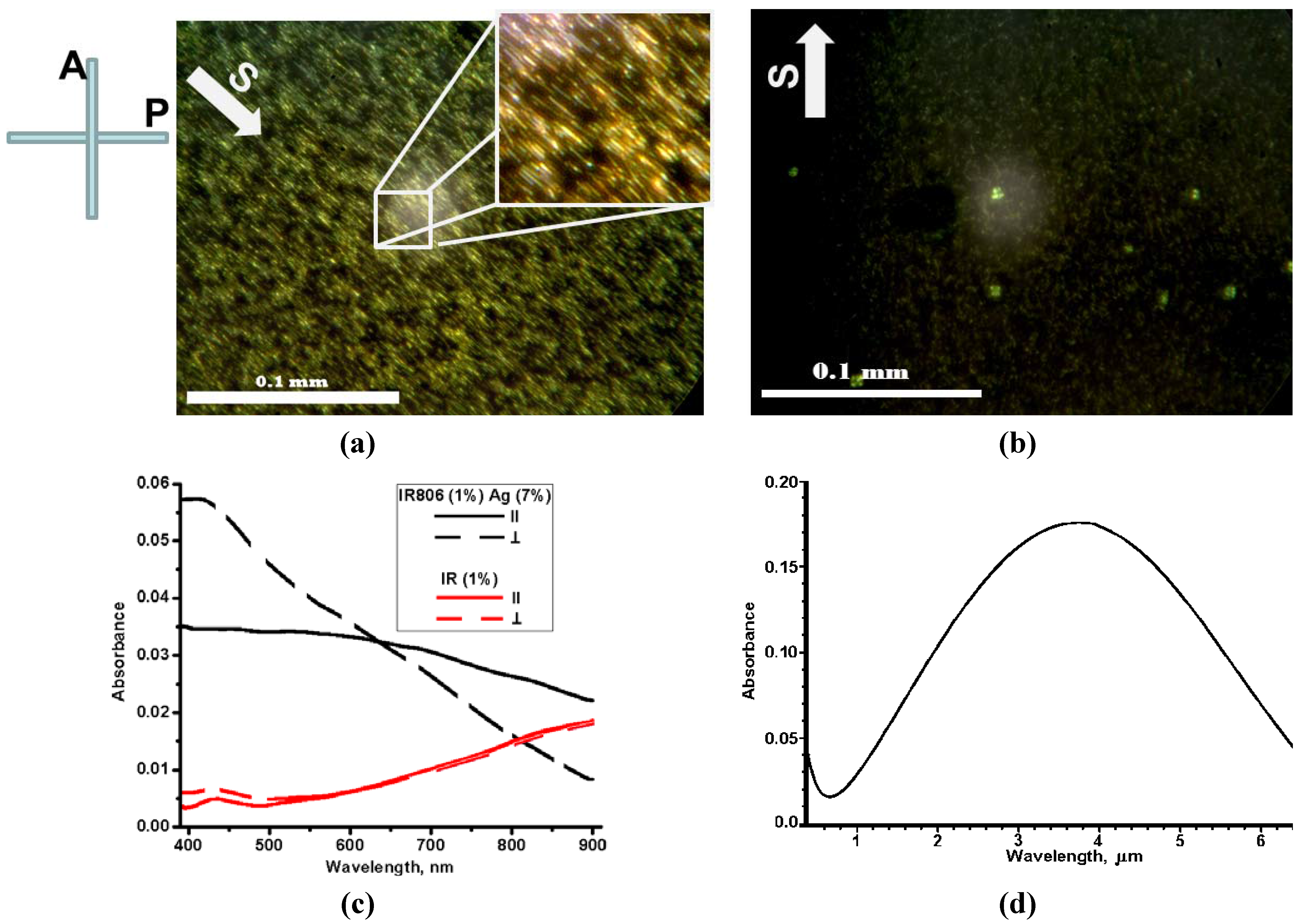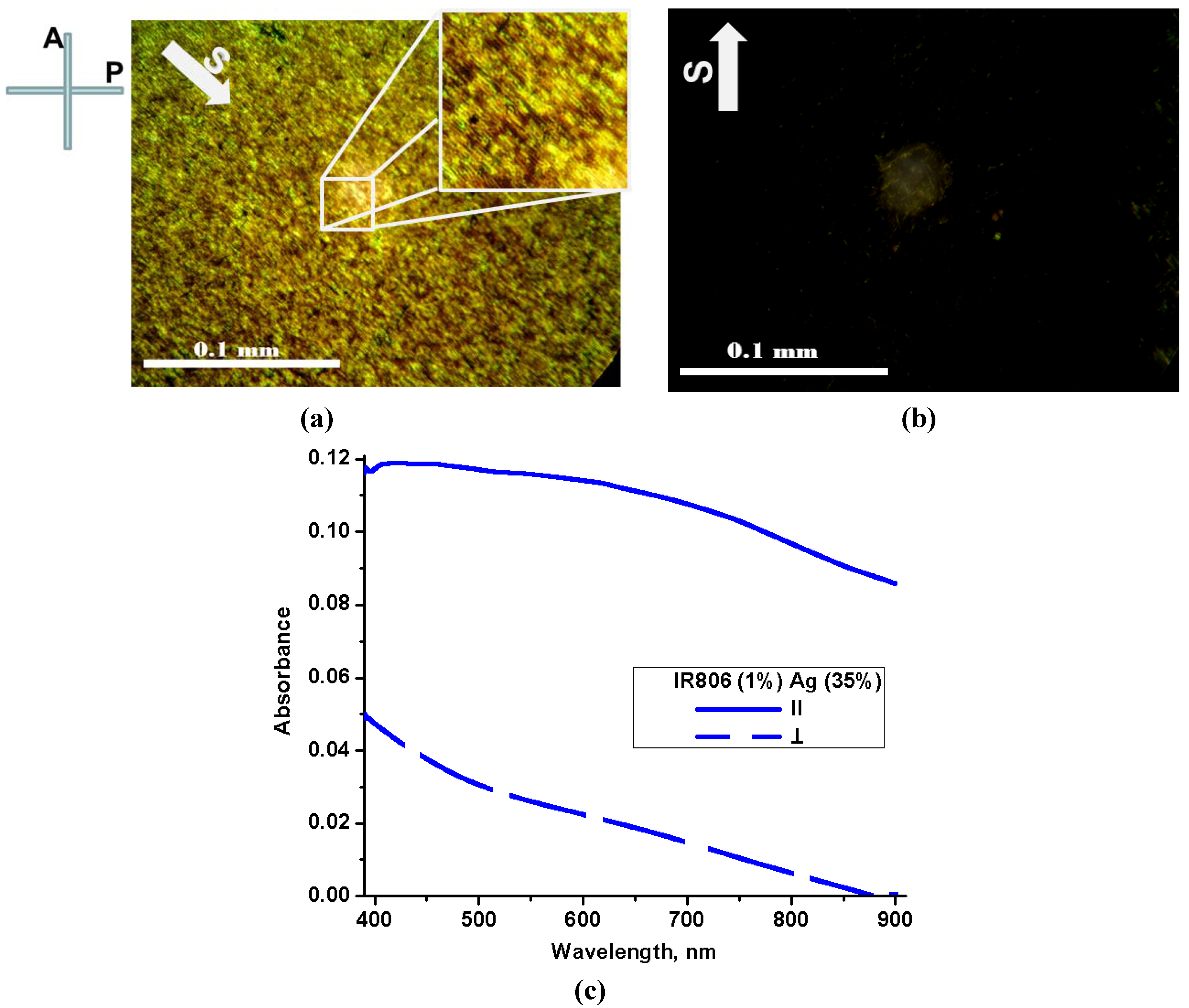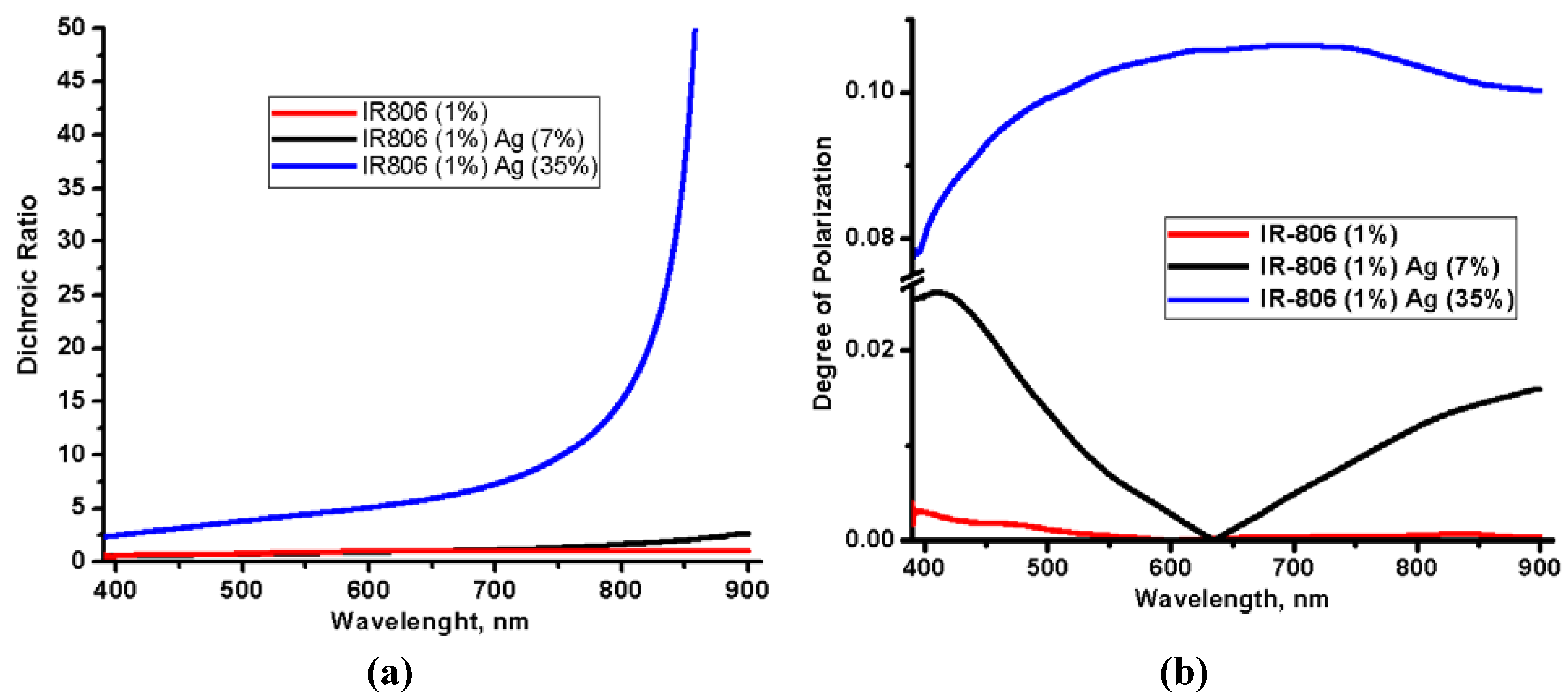2.1. Overlapped Silver Nano-Fibers
The metal nano-particles dispersed in coloidal solutions might be obtained by using the seed mediated growth method reported by B. Nikoobakht and M.A. El-Sayed [
8]. This technology allows one to prepare metal nano-particles grown in micelles of cationic surfactants (e.g., hexadecyltrimethylammonium bromide (CTAB)). Molecules of CTAB create a bilayer of positively charged coat around each particle. On one hand, the long-range electrostatic repulsion of CTAB coats keeps nano-particles well dispersed in water. On other hand, the same repulsion presents difficulties for the uniaxial alignment of metal nano-particles.
Figure 1 demonstrates an example of such alignment affected by repulsion between silver nano-fibers. To prepare this example of dried silver nano-fibers, a droplet of silver nano-fibers aqueous dispersion NGAP NF Ag-3101-W was sheared by using a metal doctor blade on the surface of bare borosilicate glass,
Figure 1a. Once water evaporated, the silver nano-fibers were “frozen” in their positions. This dried layer of silver nano-fibers was marked as Sample No. 1. To observe the texture of frozen silver nano-fibers, Sample No. 1 was placed in view of polarizing microscope, between crossed polarizer P and analyzer A,
Figure 1b. The silver nano-fibers are seen as long lines with mutual overlie angle of 90 degrees. Obviously one part of the nano-fibers was aligned along the shearing direction S and another part of nano-fibers is overlapped and oriented orthogonally to S direction. Such an orthogonal overlap texture indicates on the repulsive electrostatic interaction between the nano-fibers.
Figure 1.
(Color online) (a) Shearing setup with the layer of silver nano-fibers (1), doctor blade (2) with applied force F, droplet of the colloidal dispersion (3), and bare borosilicate glass plate (4); (b) The microspore texture of Sample No. 1 with dried silver nano-fibers NGAP NF Ag-3101-W, which was captured between crossed polarizer (P) and analyzer (A). Vector S depicts the direction of shearing.
Figure 1.
(Color online) (a) Shearing setup with the layer of silver nano-fibers (1), doctor blade (2) with applied force F, droplet of the colloidal dispersion (3), and bare borosilicate glass plate (4); (b) The microspore texture of Sample No. 1 with dried silver nano-fibers NGAP NF Ag-3101-W, which was captured between crossed polarizer (P) and analyzer (A). Vector S depicts the direction of shearing.
2.2. Silver Nano-Fibers Oriented by the Shearing Force
In 2008 Park and Lavrentovich [
9,
10] found technique for assembling gold nano-rods to either side-by-side or end-to-end stacks. Within this technique, the electrostatic interaction between nano-particles might be decreased by adding self-assembled molecular aggregates with electrical charges of the opposite sign into a common solvent such as water. The electrostatic attractive interaction acting between the nano-particles and molecular aggregates tie them together into assembled structures in water.
To prepare a dispersion of nano-particles stacks in nematic lyotropic liquid crystal we used the aqueous dispersion of silver nano-fibers NGAP NF Ag-3101-W and infrared dye IR806. It is known that the rod-shaped J-mesoaggregates of IR-806 dye form nematic lyotropic liquid crystals in aqueous solutions if its weight concentration is in the range 0.7–10% [
11]. Thus, we added 0.0093 g of IR-806 to 1 g of NGAP NF Ag-3101-W to form 1% aqueous solution of infrared dye IR-806. After infrared dye was completely dissolved, a droplet of colloidal solution was sheared on the bare surface of borosilicate glass slide and left to dry at room temperature. After water evaporated this dried layer of nano-fibers was marked as Sample No. 2.
Figure 2 demonstrates textures of the dried Sample No. 2 placed between crossed polarizer P and analyzer A in the polarizing microscope. The dried silver nano-fibers were aligned along the shearing direction S. Also, texture in
Figure 2a clearly demonstrates that the nano-fibers formed “raft” structures with side-by-side assemblies described by [
9,
10] for wet samples of gold nano-rods.
Absorption spectra of Sample No. 2 were measured with lights linearly polarized along (∥) and orthogonally (⊥) to the shearing direction S,
Figure 2c. The linear polarization was achieved by using the pile of the quartz plates. Because lyotropic liquid crystals at certain concentrations and temperatures form aqueous nematic solutions, their sheared and then dried layers capable of the dichroic polarization (see for example References [
12,
13]), for the sake of comparison,
Figure 2c demonstrates reference spectra of sheared dye IR-806 prepared in the similar way to Sample No. 2. The aligned silver nano-fibers in Sample No. 2 clearly demonstrate an anisotropic transmission of dichroic crystalline layer. In visible, from 400 to 650 nm, the high value of orthogonal absorbance (⊥) is caused by transvers plasmon absorption in the aligned nano-fibers. In further wavelength range, from 650 to 900 nm, the orthogonal absorbance decreased and longitudinal plasmon demonstrated dominance by increasing magnitude of the parallel absorbance (∥). By using simulations of optical absorption spectra described by M.A. El-Sayed [
14], we modeled infrared absorption spectrum of the silver nano-fibers NGAP NF Ag-3101-W,
Figure 2d. Maximum value of the parallel absorbance is anticipated in the center of longitudinal plasmon resonance at wavelength of 3.75 μm. Thus, the samples with aligned silver nano-fibers demonstrate even higher values of the parallel absorbance starting from near-infrared.
Figure 2.
(Color online) (a) and (b) Textures of Sample No. 2 (dried silver nano-fibers with the infrared dye IR-806) placed between crossed polarizer P and analyzer A, with two different orientations of shearing direction S with respect to P and A; (c) Absorption spectra of Sample No. 2 (black line) and same for reference film of dried infrared dye IR-806 (red line) measured with visible and near-infrared lights linearly polarized along (∥) and orthogonally (⊥) to the shearing direction S; (d) Infrared absorption spectrum of the longitudinal plasmon calculated for the silver nano-fibers NGAP NF Ag-3101-W.
Figure 2.
(Color online) (a) and (b) Textures of Sample No. 2 (dried silver nano-fibers with the infrared dye IR-806) placed between crossed polarizer P and analyzer A, with two different orientations of shearing direction S with respect to P and A; (c) Absorption spectra of Sample No. 2 (black line) and same for reference film of dried infrared dye IR-806 (red line) measured with visible and near-infrared lights linearly polarized along (∥) and orthogonally (⊥) to the shearing direction S; (d) Infrared absorption spectrum of the longitudinal plasmon calculated for the silver nano-fibers NGAP NF Ag-3101-W.
In order to increase the load of silver nano-fibers, the solution NGAP NF Ag-3101-W was centrifuged for 30 minutes with frequency of rotation 8,000 rpm. Amount of deionized water was decreased, and then the silver sediment was re-dispersed by using an ultrasound bath. The weight concentration of the silver nano-fibers in water was increased up to 35%.
Then, in order to preserve the weight concentration of the infrared dye at the level of 1%, 0.0066 g of IR-806 dye were added to 1 g of the concentrated aqueous dispersion of silver nano-fibers. After the infrared dye was completely dissolved, solution was sheared on the glass substrate similarly to the previous two samples. New sample was left to dry at room temperature and marked as Sample No. 3.
Figure 3a,b demonstrates textures of the dried Sample No. 3 placed between crossed polarizer P and analyzer A in the polarizing microscope. The dried silver nano-fibers were aligned in uniaxial fashion along the shearing direction S,
Figure 3a.
Absorption spectra of Sample No. 3 were measured in linearly polarized lights as absorption spectra of Sample No. 2 and depicted in
Figure 3c.
Figure 3.
(Color online) (a) and (b) Textures of Sample No. 3 (concentrated silver nano-fibers with the infrared dye IE-806) placed between crossed polarizer P and analyzer A, with two different orientations of shearing direction S with respect to P and A; (c) Absorption spectra of Samples 3, (blue lines) measured with lights linearly polarized along (∥) and orthogonally (⊥) to the shearing direction S.
Figure 3.
(Color online) (a) and (b) Textures of Sample No. 3 (concentrated silver nano-fibers with the infrared dye IE-806) placed between crossed polarizer P and analyzer A, with two different orientations of shearing direction S with respect to P and A; (c) Absorption spectra of Samples 3, (blue lines) measured with lights linearly polarized along (∥) and orthogonally (⊥) to the shearing direction S.
The higher load of silver nano-fibers improves dichroic properties of the aligned structure of silver nano-fibers.
Figure 4a demonstrates such improvement of dichroic properties by depicting spectra of the dichroic ratios
R defined as
R = A∥ ⁄A⊥, were
A∥ and
A⊥ are absorbance measured with lights linearly polarized along (∥) and orthogonally (⊥) to the shearing direction S, respectively. The dichroic ratio of the layer with the low load of silver nano-fibers (Sample No. 2) demonstrates minor improvement over the dichroic ratio of the reference layer with the infrared dye IR-806 (compare black and red lines). The layer with the high load of the silver nano-fibers (Sample No. 3) demonstrates at least one order higher value of dichroic ratio (blue line) in comparison with other two spectra. The improvement is much higher in the near infrared range, which is closer to center of the longitudinal plasmon absorption of aligned silver nano-fibers.
Figure 4 also describes improvement of linear polarization of light transmitted by the Samples No. 3. We used concept of the degree of polarization [
15,
16] defined as a ratio
V = (Imax − Imin)/(Imax + Imin), where
Imin and
Imax are maximum and minimum intensities of linearly polarized light transmitted along and orthogonally to the shearing direction S, respectively.
Figure 4b demonstrates that the degree of polarization of light after Sample No. 3 is higher by one order of magnitude than degrees of polarization of Sample No. 2 and reference layer of IR-806 dye.
Figure 4.
(Color online) (a) Dichroic ratio and (b) degree of polarization of reference layer of IR-806 (red), Samples No. 2 (black), and Samples No. 3 (blue).
Figure 4.
(Color online) (a) Dichroic ratio and (b) degree of polarization of reference layer of IR-806 (red), Samples No. 2 (black), and Samples No. 3 (blue).








